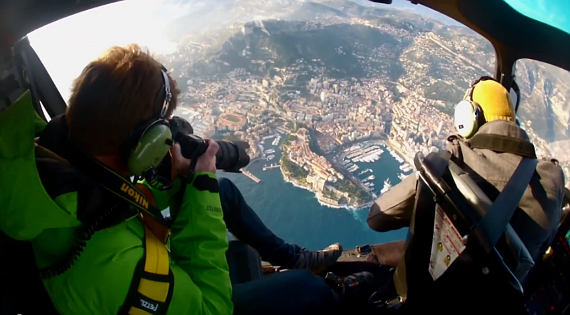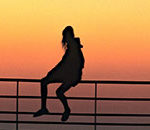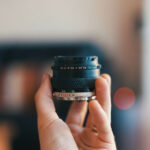Chase Jarvis is a well-known name among photographers, especially the Nikonians. Jarvis has shot for some of the biggest names in the corporate world including Apple, Volvo, Nike, Microsoft, Red Bull, Honda, and Polaroid. Today, Jarvis gives us some tips on how to take aerial photographs from inside a helicopter, a method of photographing which he highly recommends:
Jarvis’s Tips for Aerial Photography:
- Never walk around the tail end of the helicopter
- Always make sure you and your gear is safely secured to the helicopter
- Bring multiple cameras to avoid switching lenses
- Use memory cards with a lot of storage space to avoid switching them out
- Don’t use a lens hood as it will be harder to hand-hold the camera and may come off during flight
- Sit on the same side as the pilot so that you are viewing the same scene and can communicate easier
- Shoot at a very high shutter speed (at least 1/1000th) to overcome camera shake

Always sit on the same side as the pilot so that you are both looking at the same thing
Jarvis’s biggest tip is to always listen to the pilot. They’re experienced at what they do, and they know a lot more that you will. So always pay attention to what your pilot says as he/she is following safety procedures.
“Generally speaking, when we shoot from a helicopter, you shoot with the doors off. So call ahead, it sounds like a big deal, but it’s really not. It’s something they can do in a matter of minutes.”
Like This Article?
Don't Miss The Next One!
Join over 100,000 photographers of all experience levels who receive our free photography tips and articles to stay current:






I love your blog post about photography tips from a helicopter. It’s clear that you’re a well-known name among photographers, and your photography tips are incredibly helpful. I’m especially interested in your tips for aerial photography. I think that’s something that’s really exciting to learn about and I’ll definitely be looking into it!
Thank you so much for giving insight into your work. Some legitimate tips I’ve already been captured :) Hope so, we need to make sure the safety, first. Last month I got a depressed news that helicopter crash kills five photographers. The possible reason was that one of the bags from photographers in the helicopter hits the emergency fuel as a result shutoff the switch. So we need to take over the solution which is safe and releasable at the same time during the heli photography.
Some great tips there thanks for sharing I’m doing my second shoot from a helicopter tomorrow photography another brand new chopper flying next to a boat that’s full of crocodiles. The tip with the lens hood I’ve definitely taken on board the last thing I want is something flying off and landing in the rotors Cheers Spokz
Great tips. It is never easy to shoot from a heli. Following the advice listed in this article will put you on the right path to amazing aerial shots.
I’ve always been awestruck by aerial photographs, but I am kind of afraid to give it a try, especially in a helicopter, but then you can’t really capture photographs from a plane which are anywhere near as good as the ones captured from a helicopter.
ADDENDUM:
Shooting from fixed wing is FAR smoother than chopper which is similar to supporting a camera on a pogo stick/ jackhammer.
If money is no issue, buy a gyro camera stabilizer which will give you at least 3 stops in shutter speed.
If you can afford a few fixed wing lessons (or better still, fixed wing lisense) you can fly right hand seat (door off) next to your instructor/pilot friend or colleague, and be able to set up your approach EXACTLY as YOU need for your picture and ask him to hold this approach. Who can be more ‘photo savvy’ (for YOUR pictures) than yourself?
PLUS, with your own pilots’ lisense, you will then be able to get a DRONE lisense, and ¥#!!!!!! those OUTRAGEOUS chopper/pilot fees.
A polarizer is ONLY effective on a reflection from a source NOT behind NOR in front of you and NOT off metallic surfaces AT ANY ANGLE.
UNLESS you are hovering (which is DANGEROUS at low level), finding the exact viewpoint for best polarization not practical at speed. ALSO, the density alone of the polarizer will cause (approx./at least) a 1 stop loss with (up to) a further loss of 1 to 2 stops as you rotate the polarizer.
You would be better off without the polarizer and choose best time of day for best lighting if you have this option.
Hi Jarvis,
great tips. I’m preparing for my first helicopter shooting as a hobby photographer. Taking my D600 with a normal lenses.
Do you recomend a polarized filter during the shooting? It will be in winter and quite a lot of reflections from the snow.
Thanks again
Gustavo
I was a helicopter pilot and a commercial photographer back in the 70’s and early 80’s and what I found very helpful ( when the photographer) was to have a pilot that was ‘ photo savvy’ . I was busy and successful both as a pilot and a photog but I had a pilot that did not ‘ see’ the picture it was very difficult to get the pictures I needed.
So… Ask for a pilot that is a photographer or is at least aware of what you are looking for and enjoy the experience. Helicopters are cool!
Ed
Thanks for the great tips! It’d be cool to hear more about how you control camera movement/shake when you’re shooting video. Are the ISO/SS/Aperture settings you discussed for stills only or are they what you use for video as well?
Having lost a lens hood a few a times; I completely related to the tip about not using the lens hood. It’s one thing to pick it up off the ground and snap it back on. Entirely different to say sayonara to one from a few thousand feet. Then I chuckled when I saw the image used in the article had his attached.
WOW!! What a great thing to be able to do!
Great tips for aerial shots, thank you.